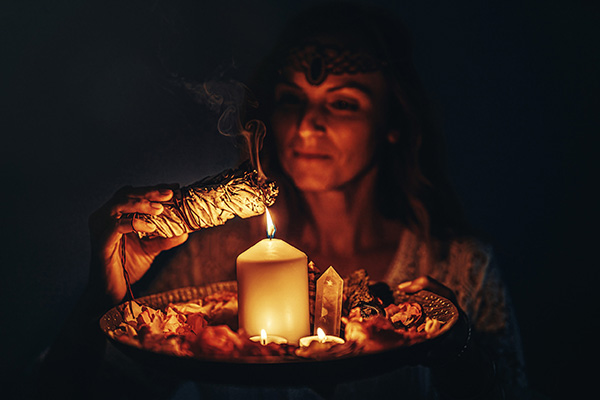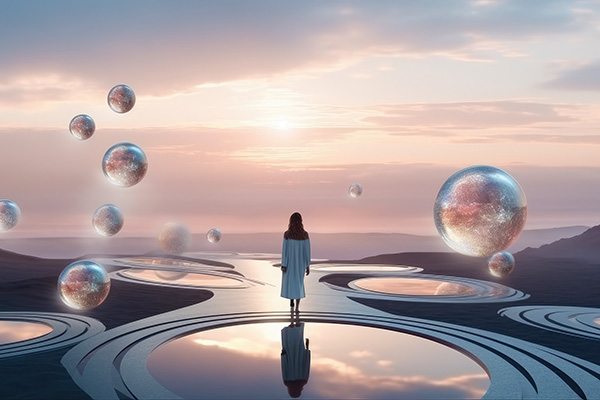Manifesting Success With The Law Of Assumption
 We’re often told not to make any assumptions about people, situations, or outcomes. Common wisdom suggests we should avoid the pitfalls of ‘jumping to conclusions’ or ‘getting ahead of ourselves.’
We’re often told not to make any assumptions about people, situations, or outcomes. Common wisdom suggests we should avoid the pitfalls of ‘jumping to conclusions’ or ‘getting ahead of ourselves.’
But when it comes to successful manifestation, making assumptions is actually one of the best things you can do! In fact, it’s often exactly what we should be doing to manifest more of our desires.
If you’ve been craving change but struggling to manifest the life you want, the Law of Assumption could be just what your manifestation practice needs. This technique is often the missing piece that helps break the cycle of stagnation and clears the way for you to manifest your desires with greater success.
The Law of Assumption is that whatever you assume to be true, whether consciously and unconsciously, will manifest in your life. By aligning your thoughts, feelings, and actions with the belief that your desire is already fulfilled, you can more effortlessly create the life you want.
In my psychic work, I’ve seen firsthand how this law can be a game changer. It’s a powerful manifestation tool that turns obstacles into opportunities and has helped many of my clients finally create the life they’ve always dreamed of.
If you’re feeling stuck and unable to manifest what you want, it’s probably because you’re unknowingly operating from a place of lack, fear or resistance. You may be doing all the right things – visualizations, prayers, rituals, affirmations – but deep down you may still be holding onto doubts or limiting beliefs that are in direct conflict with what you’re wanting to manifest. Continue reading
The Ancient Spiritual Tradition Of Smudging
 Just as our physical environment can become cluttered and unclean, our aura or energy field also accumulates stagnant and negative energy.
Just as our physical environment can become cluttered and unclean, our aura or energy field also accumulates stagnant and negative energy.
Regularly cleaning our homes and workplaces promotes health, hygiene and optimal function — and the same principle applies to our personal and spiritual energy. Clearing our energy field and environment helps to release negativity and toxic emotions, stress and anxiety, and promotes a sense of calm, clarity and balance.
Energy cleansing is essential for removing blockages that may be hindering personal and spiritual growth or disrupting your connection to spirit and the divine. Over time, lingering negative or toxic energy can even manifest as mental health issues, spiritual disconnection and even physical ailments.
By maintaining a regular practice of energy cleansing, you create a positive, harmonious flow of energy that supports overall health and well-being. In addition, a clear energy field sharpens your intuition and inner guidance, making it easier to align with your higher self and make decisions that are aligned with your greatest good.
Smudging is also a powerful way to clear negative energy attachments and banish malevolent spirit entities.
One of the most time-tested and effective methods of clearing unwanted energy is smudging, or smoke cleansing — an ancient purification ritual steeped in history and practiced by various cultures, religions, and spiritual traditions around the world.
Using Crystals To Attract Love And Money
 Crystals, with their metaphysical properties and magical allure, are a powerful tool for attracting love and prosperity as we enter a new year. By harnessing their unique energies to power our intentions, we can manifest more of the life we desire.
Crystals, with their metaphysical properties and magical allure, are a powerful tool for attracting love and prosperity as we enter a new year. By harnessing their unique energies to power our intentions, we can manifest more of the life we desire.
The metaphysical properties of crystals come from their unique molecular structure that resonates at certain frequencies. When we work with crystals, we are essentially aligning and amplifying our own energy field with these frequencies to amplify our intentions and manifest our desires by resonating more powerfully with the vibrations of the things we wish to attract into our lives.
Crystals and gemstones have been used for centuries in various cultures for their metaphysical power, healing properties, and ability to aid in magic and manifestation.
The ancient Egyptians valued crystals for both decorative and spiritual purposes. Egyptian priests and healers routinely used crystals for sacred rituals and healing, knowing that these stones had the power to connect them to the divine and balance energies.
In the Middle Ages, amethyst was often worn by the Christian clergy as a symbol of purity and spiritual wisdom. Garnet, another popular gemstone, was used as a talisman for protection during travel and to inspire love and devotion. In some Christian churches, chalices and crosses continue to be adorned with precious gems to symbolize sacred and divine qualities.
Paranormal, Or Perinormal?
 When we hear the word “paranormal,” we often think of ghosts, psychic abilities, or UFO sightings. But what does the term really mean?
When we hear the word “paranormal,” we often think of ghosts, psychic abilities, or UFO sightings. But what does the term really mean?
Many of us have had moments that feel mysterious or beyond our understanding — experiences that challenge the way we see the world. What’s interesting is that these experiences aren’t always “paranormal” in the traditional sense — they may actually be “perinormal.”
Understanding the difference between these two ideas can help us see our everyday experiences in a new light, making it easier to connect with the mystical side of life without feeling overwhelmed by the unknown.
“The word “paranormal” comes from the Greek word “para,” which means “outside” or “beyond” normal. It refers to things that are beyond the limits of what we can scientifically measure or explain.
Paranormal experiences, such as ghost sightings or psychic phenomena, defy logic and leave a lasting impact on those who experience them. They’re those mystical or supernatural experiences that break the rules of reality and are completely “outside of normal.”
“Perinormal, on the other hand, comes from the word “peri,” meaning “around” or “near.”. These experiences are on the edge of “normal” — they’re those things we sense, feel, or observe that are related to subtle, measurable energies or natural laws, but also remain mysterious and unexplained.
Perinormal experiences show us that the spiritual and mystical are often much closer to reality than we realize – they just exist in a space we do not yet fully understand, or perhaps never will?
Master Your Dream Experiences With Lucid Dreaming
 Sometimes we experience dreams so graphically that they blur the line between fantasy and reality. We’ve all had those amazingly vivid dreams of winning the lottery, flying over a city, or meeting a beloved celebrity, only to wake up and wonder for a moment, “Did it really happen?
Sometimes we experience dreams so graphically that they blur the line between fantasy and reality. We’ve all had those amazingly vivid dreams of winning the lottery, flying over a city, or meeting a beloved celebrity, only to wake up and wonder for a moment, “Did it really happen?
These dreams leave us longing to relive them, to feel the thrill of those amazing moments again. The good news is, it is possible! We can control our dreams, shape the narrative, and bend reality as we sleep through lucid dreaming-a practice that allows you to shape and control your dreams.
By practicing lucid dreaming, you unlock and enjoy a whole new dimension of your subconscious mind and the astral realm.
Lucid dreaming occurs when you become consciously aware that you’re dreaming while still in the dream. This awareness opens up a potential playground where the usual laws of physics are suspended, allowing you to create, manipulate, and explore any dream scenario you desire. Unlike typical dreams, where events unfold outside of your control, lucid dreaming puts the dreamer in the driver’s seat.
Lucid dreaming techniques tap into your brain’s natural creative processes, allowing you to influence the storyline, environment, and even the people in your dream world. Scientific studies have shown that lucid dreaming is a real phenomenon and not just an abstract concept or superstition. Research has also demonstrated that lucid dreaming can be cultivated through various techniques, and it has been studied extensively in the fields of psychology and neuroscience.
Karmic Healing: Can You Handle The Truth?
 In the famous courtroom drama A Few Good Men, Jack Nicholson’s character, Colonel Jessup, exclaims in an iconic movie moment, “You can’t handle the truth!”
In the famous courtroom drama A Few Good Men, Jack Nicholson’s character, Colonel Jessup, exclaims in an iconic movie moment, “You can’t handle the truth!”
I suspect this scene has become legendary in movie history because it resonates so deeply with most people. On some level, many of us sometimes struggle to face the truth about ourselves and our lives.
Whether it’s difficult memories, unhealed wounds, failed relationships, or unspoken regrets, facing our truth can be challenging, even traumatic or overwhelming.
Yet, from a spiritual perspective, facing and owning our truth is one of the most powerful steps we can take on our path to karmic healing and soul growth.
Our soul journey is a karmic balancing act in which the energy we put out into the world eventually comes back to us. When we hide from our truth – whether through denial, justification or avoidance – we accumulate karmic debt.
Like a heavy boulder that we carrry around, karmic debt hinders our soul growth and spiritual progress. On the other hand, when we consciously choose to face our truth, we release this burden and open ourselves to healing, growth, fulfillment and inner peace.
Denial is our most common response to unpleasant truths. We tend to avoid acknowledging aspects of ourselves that we find unattractive, justify our negative behaviors, and make excuses for our bad choices and failures in order to protect our fragile human egos. However, these “untruths” build up over time. By avoiding them, we create layers of illusion that distance us from who we really are and cloud our understanding of our soul purpose and the divine spark within.

